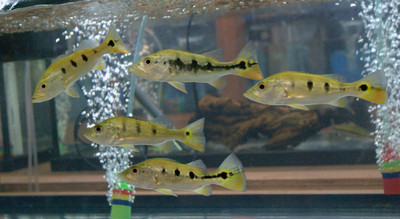The Mono Peacock Bass in Aquariums: A Captivating Aquatic Trophy
Posted by Max Gandara on on 16th Apr 2024
The Mono Peacock Bass in Aquariums: A Captivating Aquatic Trophy
While the Mono Peacock Bass (Cichla monoculus) is primarily known as a prized game fish in the rivers and lakes of the Amazon basin, its allure extends beyond the realm of angling into the world of aquariums. With its striking appearance, fierce demeanor, and impressive size, the Mono Peacock Bass has earned a special place in the hearts of dedicated aquarists seeking a taste of the Amazonian wilderness within the confines of their own homes. Let's dive into the captivating world of keeping Mono Peacock Bass in aquariums and explore the challenges and rewards of housing these majestic predators.
Origins and Characteristics: Mono Peacock Bass, also known as Monoculus Peacock Bass or Mono Eyed Peacock Bass, originate from the expansive waterways of South America, particularly the Amazon River basin. They are part of the Cichlidae family, which includes a diverse array of freshwater fish species. Mono Peacock Bass are characterized by their robust build, large mouth, and striking coloration. Their bodies are adorned with vibrant hues of green, gold, and turquoise, complemented by vertical bars or stripes in their juvenile stage. As they mature, these patterns often fade, leaving behind a solid, iridescent coloration with a distinctive dark spot at the base of their tail, from which they derive their name.
Aquarium Considerations: Housing Mono Peacock Bass in aquariums presents a unique set of challenges due to their large size, aggressive nature, and predatory instincts. A spacious tank with ample swimming space and hiding places is essential to accommodate their active lifestyle. A tank size of at least 200 gallons is recommended for a single adult Mono Peacock Bass, with larger tanks required for multiple specimens or tank mates. The tank should be equipped with a powerful filtration system to maintain water quality, as Mono Peacock Bass are messy eaters and produce a significant amount of waste.
Substrate should consist of smooth gravel or sand to prevent injury to the fish's delicate fins and mouth. Driftwood, rocks, and PVC pipes can be added to provide shelter and create territories within the tank. Live or artificial plants can also be included, although Mono Peacock Bass may uproot or consume them.
Feeding and Diet: As carnivorous predators, Mono Peacock Bass require a protein-rich diet consisting primarily of meaty foods. In the wild, they prey on a variety of aquatic organisms, including fish, crustaceans, and insects. In captivity, they can be fed a varied diet of high-quality pellets, frozen or live foods such as feeder fish, shrimp, and earthworms. Feeding should be done sparingly to prevent overfeeding and maintain water quality.
Compatibility and Tank Mates: Due to their aggressive nature and predatory instincts, Mono Peacock Bass are best kept as solitary specimens or in large tanks with compatible tank mates. Tank mates should be of similar size and temperament, as smaller or more docile fish may become targets for aggression or predation. Suitable tank mates include other large cichlids, catfish, and certain species of armored or fast-swimming fish.
The Mono Peacock Bass is a captivating and formidable addition to freshwater aquariums, prized for its beauty, strength, and commanding presence. While housing these majestic predators requires careful consideration and dedication, the rewards of observing their natural behaviors and interactions far outweigh the challenges. With proper care and attention to their habitat requirements, aquarists can enjoy the thrill of keeping Mono Peacock Bass and create a stunning aquatic display that mirrors the untamed beauty of the Amazonian wilderness.

